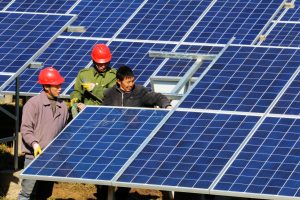Though most of the coverage of China’s Third Plenum has centered around the lack of a clear path to revive economic demand, there were encouraging signs for China’s decarbonization efforts.
The Third Plenum is held every five years — although this year’s was over six months delayed — and it is often the staging ground for the Central Committee to announce medium- and long-term policies. In this year’s iteration, there was a significant announcement about the future of China’s “dual energy consumption control” system, or “dual control.”
Dual control refers to China’s policy of controlling both total energy consumption and energy intensity. Energy intensity is measured as a percentage of energy usage per unit of GDP, and the goal of the policy has been to make the Chinese economy more energy efficient.
The policy update, released on July 21 in the Central Committee’s “Decisions on Further Comprehensively Deepening Reform and Promoting Chinese-Style Modernization” (hereafter referred to as “Decisions”) shifted the focus of dual control away from energy consumption and onto carbon emissions. Rather than focusing on total energy consumption and energy intensity, dual control will gradually shift to control total carbon emissions and emissions intensity at the regional, industry, and firm level.
China first implemented the dual control policy in the 13th Five-Year Plan, which was proposed in 2016. Since then, dual control has developed through subsequent policy updates, most notably in November 2022 and July 2023.
In November 2022, the National Development and Reform Commission, National Energy Administration, and the National Bureau of Statistics jointly published a policy document, which stipulated that energy consumption growth from renewable sources would not be covered under dual control. Just eight months later, in July 2023, the Central Commission for Comprehensively Deepening Reform indicated that the dual control mechanism would gradually switch to controlling emissions, rather than energy consumption, per Xinhua.
This latest update following the Third Plenum is the culmination of that policy progress.
It’s important to note that this change has not yet taken effect, and the Decisions document lacks specifics about when it will occur. All the same, this change has significant implications for China’s decarbonization as well as for companies operating in China. Under this forthcoming change, energy intensive industries will be able to grow faster, assuming they can control their emissions. The forthcoming change will also further accelerate China’s energy transition.
Cai Yuanji, deputy director of the Power Market and Carbon Market Research Institute of the Tsinghua Sichuan Energy Internet Research Institute, emphasized these two benefits in comments to Caixin. Cai argued that although China’s total energy consumption is high, per capita energy consumption is still relatively low. The result is that too strict a cap on increases in energy usage, especially increases coming from renewable sources, will hamper China’s economic development at a time when policymakers need to stimulate growth.
Cai further argued that this change will better align dual control with China’s other goals like the carbon peaking and neutrality goal, which measures total emissions, as well as China’s Emissions Trading Scheme (ETS), which measures emissions as a percentage of GDP.
Another connection between the forthcoming version of the dual control policy and China’s ETS is a shared challenge: collecting accurate and timely emissions data. To alleviate that hurdle, the July 21 Decisions document also calls for the creation of a carbon emission statistical accounting system and a product carbon footprint management system. This builds on a plan issued by China’s Ministry of Ecology and Environment in June 2024, which called for establishing the carbon footprint management system by 2027, to be completed by 2030.
Better emissions monitoring is essential if China is to effectively control total emissions and emissions intensity under dual control, as well achieve carbon peaking by 2030. As China starts to move into the second half of the decade, having these systems in place will make reducing emissions easier.

































